Trip Report - 11-17-13
Winter fishing has never been very productive for me. One fish is a good day and two is a very good day. Today was a three fish day! Although I usually fish several different rods on any given day, I spent the whole day with the Shimotsuke Kosasa 210. I had fished the rod for small bluegills before, but I wanted to catch some micros and some trout with it.
The trout were cooperative but the micros didn't want to play. The creek chubs all hid under a bridge where I couldn't reach them and it seems like all the shiners have swum south for the winter. [No, they don't really do that, it just seems like it.]
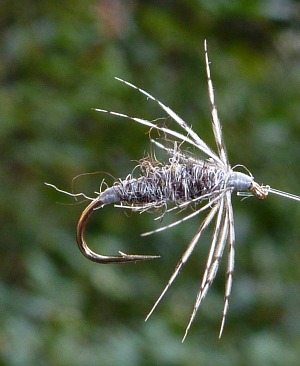 Shaela
Shaela
The fly of the day was a yarn bodied soft hackle tied with Jamieson's
Shetland Spindrift "Shaela" yarn and a gray partridge feather.
The pattern is really very similar to the Killer Kebari, which also is a dynamite fly. What I really like about the combination of a ball of Jameison's Shetland Spindrift "Moorit/Shaela" and a partridge skin is that both of the materials allow you to tie either a gray fly or a brown fly. I have done very well with these flies.
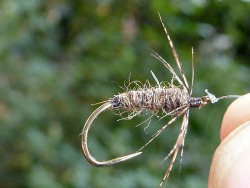 Moorit
MooritMoorit yarn (the other strand of the
two-strand Moorit/Shaela yarn), along with a brown partridge back feather feather
seems to work just as well as the Shaela with a gray partridge breast feather.
Dr. Ishigaki might suggest that you don't really need two flies, but he does tie his kebari in two variations: black body with brown hackle, and gray body with grizzly hackle.
The presentation that worked today was dead drift, fishing straight across into quiet water on the other side of a current seam. When fishing with a very short rod, and the Shimotsuke Kosasa 210 is a very short rod at just 6'10", I have done much better fishing straight across or just slightly upstream of straight across than I have fishing directly upstream or even quartering upstream. (Walking up on fish may spook them more than walking past them - it certainly works that way with game.)
The first fish of the day (pictured upper right) was about 7", signifying a wild trout. The stream I was fishing is heavily stocked in the spring but does have some natural reproduction. The state stocks 9-10" fish and 14-15" fish, but no smaller fish.
The second fish, (shown below) taken in almost exactly the same spot and only a couple casts later, was 11 1/2" (measured against the rod and then the rod measured - it's quicker that way and is a one-hand operation).
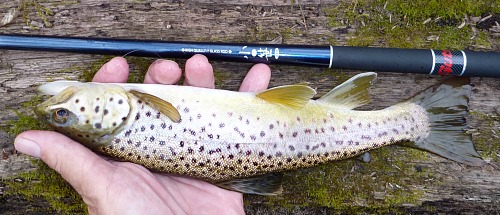
I love to fish the really light weight seiryu rods, but a 12" fish in current approaches the limit of what you can control with a seiryu rod. You can catch larger fish, but you don't really have much control over them. The rod just bends so you can't put much pressure on the fish. With the Kosasa, the rod firms up enough that you still have excellent control. The 11 1/2" fish above didn't even come close to testing the limits of the rod.
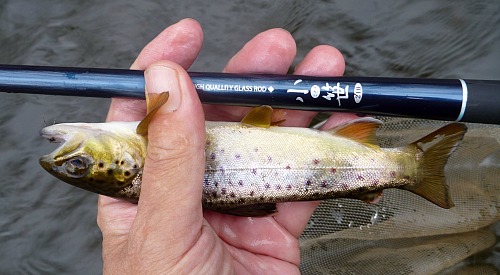
The last fish of the day was the smallest at only about 6". Still fun to catch and still capable of putting a bend in the rod.
The stream I fished today is one on which I regularly fish a 390 (or 410 or 450). For this stream a 210cm rod really is a bit short - but as I found out today, not too short to be successful. (Three fish isn't a lot, but it is more than were caught by the fly fisherman I spoke to on the way out.)
TenkaraBum Home > Trip Reports > Trip Report - 11-17-13
“The bitterness of poor quality remains long after the sweetness of low price is forgotten” - Benjamin Franklin
"Be sure in casting, that your fly fall first into the water, for if the line fall first, it scares or frightens the fish..." -
Col. Robert Venables 1662
As age slows my pace, I will become more like the heron.
Warning:
The hooks are sharp.
The coffee's hot.
The fish are slippery when wet.
Beware of the Dogma
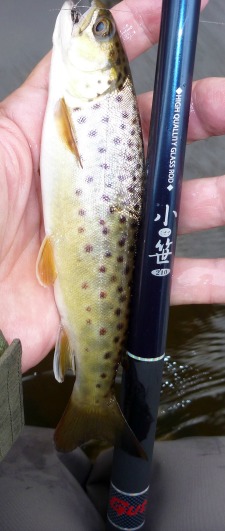
Shimotsuke Kosasa
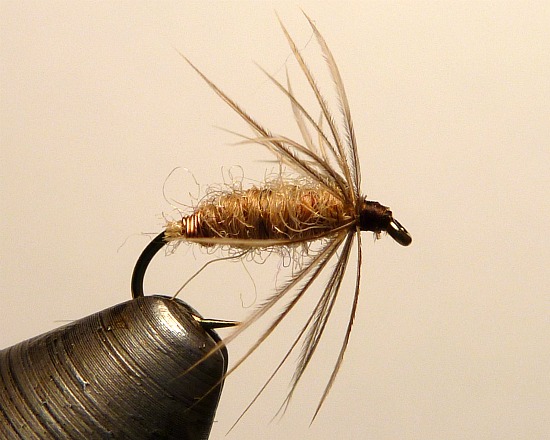
Killer Kebari


